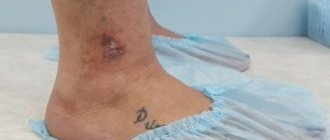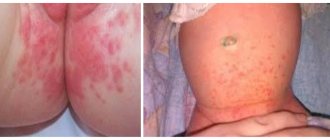YOU MAY ALSO LIKE
Newborn care
How to change diapers: useful tips
Most babies experience diaper rash at least once, even if their diapers are highly absorbent and you change them regularly. In most cases, mild diaper rash will resolve within a few days with simple treatment and your baby's skin will recover. From this article you will learn why diaper rash occurs in children, how it manifests itself, how to treat diaper dermatitis and what to do to prevent it from occurring again.
What is diaper dermatitis
Diaper dermatitis occurs when your baby's delicate diaper skin comes into contact with urine or feces for too long. As a result, diaper rash appears. Diaper rash in children looks like red, inflamed, flaky areas of skin. With proper treatment, diaper dermatitis resolves within three to four days. But if newborn diaper rash does not go away within a few days or gets worse, consult a doctor. The main rule for preventing film dermatitis is to change the diaper regularly.
| In Brief Diaper dermatitis is common. Sooner or later, all parents encounter them. Diaper rash in children is inflamed areas of skin under the diaper. After the baby has pooped, you need to change the diaper immediately - this reduces the likelihood of diaper rash. If your baby's diaper rash does not go away, consult your pediatrician. |
What does the disease look like in newborns?
At the beginning of the disease, the baby develops areas of redness and abrasion of the skin in the groin and genital area. This is the so-called diaper rash, which progresses and spreads without treatment. Large red spots merge into large areas of irritation, skin blisters, crusts, peeling, and small erosions appear. At an advanced stage, bubbles form with a cloudy liquid inside them. This indicates that a fungus or staphylococcus has joined. Source: G.S. Koval Prevention and treatment of diaper dermatitis // Issues of modern pediatrics, 2004, vol. 3, no. 5, pp. 60-64
In addition, there are subtypes of dermatitis. When a baby constantly spits up, stomach contents get into the skin folds of his neck, causing irritation. Also, sometimes the process is isolated by the inguinal folds, anus, and genitals.
To identify the type and stage of inflammation, you need to consult a pediatrician. Based on external signs, the doctor will determine why the disease appeared and how to treat the child. If the process develops and cannot be treated, more detailed diagnostics are needed. It involves taking a smear from the affected area to determine the microflora.
Why does diaper dermatitis occur?
Diaper rash can occur in babies even if you change your baby's diaper quite often. In the next section, you will learn why diaper dermatitis occurs.
Reaction to irritants and diaper dermatitis
The most common cause of diaper rash in newborns is skin irritation resulting from:
- prolonged contact with urine or feces;
- an attack of diarrhea and skin contact with liquid stool;
- teething [https://www.pampers-gorodok.ru/baby/teething] - more saliva is produced, the baby swallows it, which leads to a change in the nature of the stool, it becomes more liquid;
- the appearance of new products in the baby’s diet: the properties and composition of feces change, which can provoke the appearance of diaper dermatitis;
- contact of the baby’s delicate skin with new chemicals included in sanitary napkins, diapers, baby creams, washing powder;
- rubbing with too tight a diaper or clothing.
Symptoms:
pink or red spots on the skin under the diaper.
In this case, the inguinal folds are usually normal. What to do:
change the diaper regularly, wash the baby thoroughly or wipe it with napkins, use a protective diaper cream. The diaper should retain moisture well and fit in size, not be too tight and not rub the baby’s delicate skin.
Fungal infection and diaper dermatitis
Another common cause of diaper rash is a fungal infection. In some cases, the same fungus that causes oral thrush in infants (candidiasis) can also cause diaper rash in children. A warm and humid environment is an excellent place for pathogens to grow and multiply. And skin irritated by feces is an entry point for fungal infections. Sometimes a yeast infection appears after the baby has been treated with antibiotics or if the mother takes antibiotics while breastfeeding. Antibiotics do not differentiate between good and bad bacteria, killing both types. As a result, a fungal infection or diarrhea may develop. Diarrhea in a baby also leads to irritation in the diaper area.
Symptoms:
shiny bright red spots.
There may also be pink pimples, ulcers, and weeping or bleeding cracks in the skin. Rash and diaper rash in children caused by a fungus appear more strongly in the child’s groin folds. This is one of the signs of how you can distinguish normal diaper rash in a baby from symptoms of a fungal infection. What to do:
If you think your baby's diaper rash is due to a fungal infection, contact your pediatrician. The doctor will tell you how to treat fungal diaper dermatitis, in particular, he may prescribe the use of an antifungal cream. Wash your hands thoroughly before and after changing diapers to prevent the spread of fungus.
Bacterial infection and diaper dermatitis
It's rare, but diaper rash can be caused by a bacterial skin infection caused by staphylococci, streptococci, or a combination of the two. The infection can lead to diaper rash or worsening of existing diaper rash. Symptoms:
Bright red skin around the baby's anus is a characteristic manifestation of a streptococcal infection.
As a result of staphylococcal infection, yellow blisters appear in the affected areas, which are then covered with a dry crust. What to do:
If you think your baby's diaper rash is caused by a bacterial infection, see your doctor for diagnosis and treatment. Do not use over-the-counter antibiotic ointments to treat diaper rash unless directed by your doctor.
Allergies and diaper dermatitis
Rashes and diaper rash in children may be associated with an allergic reaction or increased skin sensitivity. Allergens and irritants can be:
- dyes in detergents or washing powder;
- elastic elements of the diaper;
- fragrances in soap, laundry detergent, conditioner or wet wipes;
- preservatives in ointments and creams;
- ingredients in baby powder, lotions and oils;
- Products - allergens can be transmitted to the baby through breast milk or directly from food when the baby begins to receive complementary foods.
Symptoms:
a rash that appears suddenly (soon after contact with the allergen).
What to do:
Try changing brands of diapers, wipes and cream for two weeks and see if the rash goes away. If the cause is a food allergy, then it is necessary to exclude the allergen from the diet. Consult your pediatrician for an accurate diagnosis and treatment recommendations.
BEST PRODUCT
Pampers® Premium Care™ for Newborns
Other causes of diaper dermatitis
Symptoms of various diseases can be mistaken for diaper rash in children. For example, atopic dermatitis is a chronic allergic inflammatory skin disease accompanied by itching. Or the rash may be caused by a rare genetic disorder such as acrodermatitis enteropathica (a disease associated with an inborn error of zinc metabolism). If you think your baby's diaper rash may be due to one of these conditions, or if you are unsure what is causing the rash, contact your pediatrician for a diagnosis and treatment.
| At a Glance There are several possible causes of diaper rash, including irritants, allergens, and infections caused by bacteria or fungi. In some rare cases, rashes and skin inflammation in the diaper area may be caused by a genetic disorder. A pediatrician can make an accurate diagnosis. |
Treatment of dermatitis in the groin
One of the most unpleasant types of skin inflammation is dermatitis on the genitals. It causes itching, soreness and discomfort. Since the skin in the genital area is especially thin and delicate, the manifestations of the disease cannot be ignored.
Inguinal dermatitis: symptoms
Manifestations of the disease depend on its stage.
- Easy. The skin on the genitals becomes red and swollen, and the patient feels discomfort.
- Average. Skin rashes appear, itching and pain are felt.
- Heavy. The bubbles merge into a single conglomerate, and erosion of the affected areas begins. An unpleasant odor, general weakness, and fever may occur.
If dermatitis is not treated, consequences such as, for example, deformation of the penis are possible. Eczema may also occur, which will recur in the future.
Causes and types of dermatitis in the groin
Depending on the etiology, there are several types of skin inflammation in the genital area.
- Candida. The causative agent of the disease is fungi. The cause may be diabetes mellitus, long-term use of antibiotics and oral contraceptives. The rash on the genitals looks like nodules or scales.
- Dermatophytic. It also has a fungal origin, but is transmitted through sexual contact, using other people's towels, and so on. It can begin due to poor personal hygiene or wearing stale underwear.
- Seborrheic. This type of inguinal dermatitis occurs in the area of the labia, penis, and anus as a result of excessive activity of the sebaceous glands. Its characteristic feature is red spots with scales.
- Erythrasma. The causative agents of the disease are bacteria, so treatment requires the use of antibiotics. Red spots and a scaly rash form in the groin area.
- Psoriasis. This type of inguinal dermatitis is incurable; its course consists of stages of remission and exacerbation. Medical care in this case comes down to reducing unpleasant symptoms and discomfort.
The causes of dermatitis on the genitals can be existing diseases - genital herpes, papillomatosis, syphilis, thrush, diabetes, gastrointestinal diseases. Often, skin inflammation occurs due to factors such as:
- heavy sweating;
- wearing synthetic underwear;
- obesity;
- allergic reactions;
- taking medications;
- neglect of hygiene standards.
How is dermatitis in the groin treated?
Dermatologists at the Private Practice clinic prescribe therapy depending on the causes of the disease, its form and severity. If inguinal dermatitis is a consequence of other diseases, treatment is carried out in combination.
In each individual case, our specialists select certain medications - antibacterial, antifungal, antihistamines, prescribe anti-inflammatory and immunomodulating agents. Ointments, lotions, and medicinal baths give a good effect. We provide recommendations for lifestyle adjustments: in particular, it is important to maintain personal hygiene and adhere to dietary rules.
Diaper dermatitis: symptoms
Diaper rash in children in the diaper area manifests itself as follows:
- small red rash, bright red spots on the skin in the area under the diaper and in the groin;
- flaky red spots on the skin;
- the affected area may appear swollen and tender, and may feel warm to the touch;
- The child may seem irritable or act restless.
If diaper rash is caused by a skin infection (fungal or bacterial), the symptoms may be more severe:
- blisters or open sores;
- blisters filled with purulent contents;
- weeping, reddened areas of skin;
- purulent discharge.
| In Brief Diaper rash in children can appear as inflamed red spots on the skin with an uneven surface, possibly flaking. In more severe forms of diaper rash caused by a fungal or bacterial infection, blisters or sores filled with pus may form. |
Types of inguinal dermatitis in women and men
Among the possible diseases, the most common diseases in the groin area are those of a fungal nature (the so-called athlete's foot inguinal and candidiasis of the folds). Bacterial diseases (erythrasma) and inflammatory dermatoses (psoriasis, contact dermatitis, benign familial pemphigus) can manifest themselves in a similar way. Children often develop diaper dermatitis in the groin area, which is primarily caused by improper care of the diaper area.
In some cases, it is impossible to make a diagnosis from a photo. In addition to examining the affected skin, a dermatologist will take a scraping to exclude the infectious nature of the disease and conduct an examination using a special ultraviolet lamp - a Wood's lamp.
Photo 1. Inguinal dermatitis.
Photo 2. Inguinal dermatitis.
How to treat diaper dermatitis and what are the methods of prevention
How to treat diaper dermatitis and how to minimize the risk of their occurrence? The methods are the same - adhere to the following rules:
- Change your diaper regularly.
A wet or dirty diaper should be changed as quickly as possible. Too much contact with urine and feces irritates the skin. Regular diaper changing is a key condition for the treatment and prevention of diaper rash.
- Use diaper cream.
Consult your pediatrician about which cream he recommends using. Diaper cream creates a protective barrier against moisture and helps prevent diaper rash. Apply the cream in a thick layer.
- Clean the skin under the diaper thoroughly with mild products.
Use fragrance-free and alcohol-free wet wipes. You can also wash your baby with water and baby detergent (not containing soap). If diaper dermatitis has already appeared, then wash the baby with running water without using special products. Don't rub diaper rash. After completing the hygiene procedures, pat the skin dry with a towel and give your baby an air bath. Before putting on a clean diaper, apply a thick layer of barrier cream to your baby's skin.
- Use
the correct size diapers .
A diaper that is too tight does not allow the skin to breathe and can also cause chafing. If the diaper fits correctly and your baby has a diaper rash that you are treating, try using looser diapers until the diaper rash goes away. - Arrange air baths.
When possible, let the baby lie down with his bottom bare. For example, you can use an absorbent diaper or towel when placing your baby on his tummy.
For your convenience, we have made a reminder about diaper dermatitis:
When to see a doctor
Contact your doctor if:
- After two or three days of treatment, the baby's diaper rash did not improve.
- In addition to diaper rash, there are also pimples, blisters, and pus-filled sores that become weepy or crusty.
- The child is treated with antibiotics and develops a bright pink or red rash with red dots around the edges.
- The rash is very painful (if you touch it).
- In addition to the rash, the child has a fever.
What can a doctor recommend?
If diaper rash does not go away or gets worse, your doctor may prescribe a special ointment or cream, such as:
- topical preparation based on hydrocortisone or steroids;
- a topical agent with an antifungal effect (in case of fungal infection);
- oral antibiotics or topical antibacterial ointment (in case of bacterial infection).
Treating diaper dermatitis with home remedies
Some studies have shown that the following may be effective for treating diaper rash:
- zinc cream;
- aloe vera;
- calendula.
If you want to try treating baby diaper rash with home remedies, consult your doctor first.
| In brief The first and most important rule for preventing diaper rash is to change the diaper as soon as the baby poops. Clean the diaper area thoroughly but gently and use barrier cream every time you change the diaper. Use high-quality, absorbent diapers and let your baby go naked whenever possible. If you follow these measures, but diaper rash still appears and does not go away, consult your pediatrician. |
FAQ
- In most cases, mild diaper rash in a baby will go away within a few days if:
- change the diaper regularly;
arrange air baths for the area under the diaper;
- use protective cream under the diaper.
The big picture
There are several types of diaper rash and they require different treatments. For the treatment and prevention of diaper rash in children, a universal rule is to regularly change a newborn’s diaper. And also thoroughly clean the skin under the diaper and apply protective cream every time you change the diaper. All of these principles apply to basic newborn skin care. If diaper rash does not go away, despite the actions described above, this is a reason to contact your pediatrician for treatment. Diaper rash in children can be caused by a fungal or bacterial infection, in which case a special ointment or medicine will be required for treatment. Even if you change your diaper regularly, you'll likely still experience diaper rash at some point. But the good news is that in most cases, diaper rash goes away within a few days, and the baby's skin recovers and becomes smooth and soft again.
How this article was written The information presented in this article is based on expert advice published by trusted (medical and government) sources such as the American Pediatric Association and the American College of Obstetricians and Gynecologists. A complete list of links to sources used to write this article can be found at the end of the article. The information on this page is not a substitute for professional medical advice. Always consult your doctor for diagnosis and treatment.






